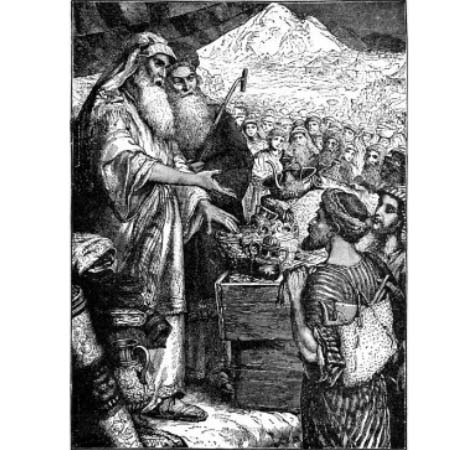As for why the name of “Bezaleel” was chosen, it is not known. Bezaleel (commonly pronounced BEZ-a-LEEL, but properly enunciated as bih-ZAL-ee-uh-L) is a major yet overlooked figure in the Bible.

In Hebrew ( בצלאל ) the name means “In the shadow of God.” He was an artificer who was the main overseer/chief architect of the work being performed on the construction of the Tabernacle (“tent of meeting”) and was in charge of the building of the Ark of the Covenant. He was assisted by his chief associate Aholiab. In addition to those duties, he was a caretaker of holy oils, incense, and vestments. As a master workman he had many apprentices in his charge. Mentions of him in the Bible will be found in Exodus 31:2–11; 35:30; 36:1–2; 37 (all); 38:1–23; 1 Chronicles 2:20; and 2 Chronicles 1:5 (KJV).
The character of Bezaleel is represented in the Scottish Rite degrees and in the Camp.
Bezaleel was an excellent choice for a name as it has produced numerous masonic and social “architects.” It is the largest Consistory in the Orient and one of the largest in the jurisdiction.
The Beginnings of Bezaleel
To augment their membership, a stellar group of men who had been previously Dubbed as Knights Templar in Ezekiel Commandery No. 3 and Red Cross Commandery No. 7 (both merged to become Emanuel Commandery No. 32 in August 1914) petitioned and were found worthy of continuing their masonic journey.
The Early Years: Selected Events
In general, virtually all activity from July 1906 through early 1910 is shrouded in mystery and lost to history; however, there is sufficient circumstantial evidence that the Consistory was functioning. In 1907, Commander Rickards was the guest of the Illustrious Commander-in-Chief. Also, that year the rituals of the Consistory were stolen. The Fraters informed Commander Rickards and secured a new set for them at a cost of $6.
In August 1909, the first documented Illustrious Commander-in-Chief, G.I.G. Cyrus H. Adams 33° passed.
In May 1910, during the 29th Annual Session held in the Valley of Philadelphia, Illustrious Boyd was elected as Illustrious Grand Minister of State. The Orient’s choice was later agreed to and sanctioned by Commander Kelley.
A precedent was set in 1912 when charter member and one of the six original Illustrious Sirs—G.I.G. William T. Anderson 33°—was made a lifetime member of the Consistory.
As the numbers of the Consistory swelled, it was not always smooth sailing as far as operations were concerned. The annual returns submitted to the United Supreme Council reflected subpar reports relating to not holding regular meetings or stagnant progress. In the early years, Bezaleel Consistory No. 15 was warned not to refuse to consider applications from properly vouched for and qualified Brothers who wished to join. Commander Rickards threatened to arrest the patent if the practice continued.
In May 1915 Illustrious Boyd sent a letter of resignation to Commander Rickards informing that his health did not permit him to continue in his capacity as the Deputy. Commander Rickards initially refused to accept the letter owing to the immense respect he held for Illustrious Boyd. However, Commander Rickards later did accept the resignation and appointed the then Illustrious 1st Lieutenant Commander of Bezaleel Consistory No. 15, G.I.G. Charles E. (Edward) Gordon 33°, as the second Most Illustrious Commander-in-Chief and Deputy for the Orient of Ohio. Illustrious Gordon held various offices in the Ohio Council of Deliberation prior to his appointment as the Deputy.
It was during the 35th Annual Session held in the Valley of Indianapolis in May 1916 that Commander Rickards 33° created the title of “Deputy Emeritus” specifically for Illustrious Boyd.
Two years later Deputy Emeritus Boyd chaired a banquet for Commander Rickards on behalf of the Consistory in September 1918.
In May 1919, during the 38th Annual Session held in the Valley of New Haven, Orient of Connecticut, Commander Rickards praised Bezaleel Consistory No. 15 for their strict adherence to the military style uniform of the day.
Commander Rickards, less than a year later in March 1920, once again visited Bezaleel Consistory No. 15 for their winter meeting. In the early years the Consistory only met four times a year.
In May 1921, Illustrious Gordon was appointed as the Illustrious Grand Master of Ceremonies.
One of the original members and primary drivers of Scottish Rite freemasonry in the Valley of Cleveland, Illustrious Benjamin M. Shook 33° passed on March 16, 1923. Illustrious Shook was an original member of both the predecessor Scottish Rite organizations to Bezaleel Consistory—White Rose Chapter and Imperial Consistory.
